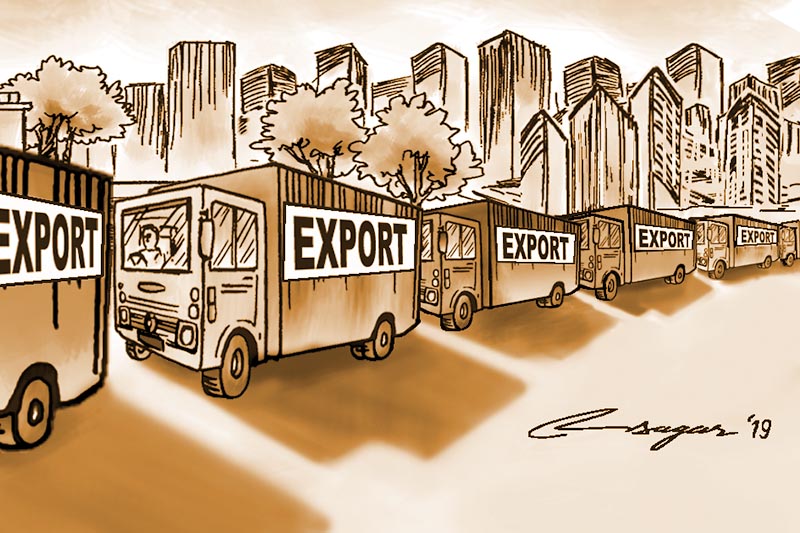Export diversification: Must to reduce trade deficit
Even though Nepal is one of South Asia’s most open and trade dependent economies, it has not been able to fully exploit the potential for export growth since its exports are focussed on a few products
It has been more than six decades since export diversification was given utmost focus in the list of priorities for development as it was observed that dependence on a few exportable commodities by developing countries exposed them to commodity shocks, price fluctuations and declining terms of trade. As a result, a country’s foreign exchange reserves and the ability to maintain funds for imported inputs become unstable and uncertain. However, a number of developing countries are still constrained by the export structure that relies on a few export products and markets.
There are a number of factors that have inspired countries to undertake export diversification, which has the potential to positively contribute to growth and development. First, increased investment in a broad range of activities and sectors enhance the sources of income and contributes to mitigating the adverse effects of export instability and fluctuations in trade.
Second, the diversification of exports is also associated with reduced fluctuations in foreign exchange earnings, increase in employment, higher value addition and improvement in the quality of manufactured products. Third, diversification is linked to economic growth via externalities of learning-by-doing and learning-by-exporting fostered by competition in world markets. Other industries can
benefit through knowledge spillovers from new techniques of production, management or marketing practices. Fourth, export diversification allows the government to achieve some of its macroeconomic objectives, such as sustainable economic growth, a favourable balance of payments situation and redistribution of income, among others.
In recent years, three developments have intensified the focus on diversification opportunities in this era of globalisation: a) the increasing spread and importance of global production chains; b) rapid growth of new sources of demand in large emerging economies, such as Brazil, China and India; and c) the growing significance of service trade propelled by rising incomes and the outsourcing of more and more service activities.
Even though Nepal is one of South Asia’s most open and trade dependent economies, it has not been able to fully exploit the potential for export growth since its exports are focussed on a few products, namely carpets, cardamom, juice, jute goods and readymade garments, and limited markets, with India’s share in Nepal’s total exports being about 57 per cent in 2017/18. Though trade is considered to be an engine of growth for economic development, market and product concentration of exports has led to volatile export growth in Nepal.
In 2017/18, merchandise exports increased 11.1 per cent to Rs 81.19 billion compared to an increase of 4.2 per cent in 2016/17. Merchandise imports, on the other hand, increased 28 per cent to Rs 1242.83 billion in 2017/18 compared to a rise of 25.5 per cent a year earlier. Country-wise, exports to India, China and other countries went up by 12.4 per cent, 43.3 per cent and 7.5 per cent respectively in 2017/18. Likewise, imports from India, China and other countries surged by 27.8 per cent, 25.5 per cent and 19.3 per cent. Consequently, the trade deficit expanded by 26.7 per cent to Rs 1161.62 billion in 2017/18 from Rs 917.06 billion in the previous year. Similarly, the export-import ratio plummeted to 6.5 per cent from 7.4 per cent in 2016/17. It went further down to 6.1 per cent during the first four months of 2018/19.
The foregoing data show that the country’s export earnings are quite volatile and have adversely affected the economy that has been specialising in the production of a narrow range of goods and services. It also needs to be recalled that to promote competitiveness and increase the production capacity to meet the domestic and international demand, the Government of Nepal had streamlined the Nepal Trade Integration Strategy’s (NTIS) list of high value goods and services with export potential, reducing the items from 19 in 2010 to 12 in 2016. Products and services in the revised NTIS include a) large cardamom, ginger, tea, herbs, fabrics, textiles, yarn, rope, leather, footwear, chyangra pashmina and knotted carpets; and b) skilled and semi-skilled professionals, IT services and business process outsourcing, and tourism. However, majority of these products have not been performing well.
To enhance export diversification, export growth, including diversification of markets and higher-value products, should be a major thrust of our trade policy. Trade and industrial policies need to target the promotion of structural reforms to improve Nepal’s efficiency and international competitiveness and reduce its vulnerability to external shocks. Secondly, an export-friendly enabling environment should be generated, which comprises sound domestic policies, sufficient infrastructure and provision of effective trade support services. Thirdly, the drive to export must not encounter frequent policy reversals and must not be compromised by other policies that have an adverse impact on the capacity of exporters to deliver.
Export diversification, both destination-wise and commodity-wise, can play an instrumental role in reducing the trade deficit. So far, however, no serious endeavours have been undertaken towards this end.
Pant writes on globalisation and trade issues






